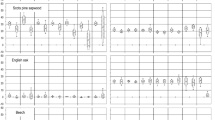Summary
A laboratory test method against soft rot is modified in a way that it is also applicable in Kolle flasks. Following a description of the test method, the conditions are discussed which have to be considered in order to obtain reproducible results. Comparatory experiments in a cooling tower are carried out using pine sapwood and taking some typical wood preservatives as examples. This is done in order to ascertain whether the results obtained by this laboratory test on the effect of wood preservatives against soft rot in beechwood permit to draw definite conclusions on the anti-soft rot effect of the impregnation of coniferous wood to be expected in practice. Some limits of the applicability of results gained on beechwood according to the laboratory test for practical use and especially in the cooling tower are discussed. Then, with the help of the laboratory test, the effects of some essential constituents of wood preservatives against soft rot are compared. Moreover, details are given on the susceptibility of some wood species and the destructive power of different soft rot fungi.
Similar content being viewed by others
Schrifttum
Findlay, W. P. K., u. I. G. Savory: Moderfäule, die Zersetzung von Holz durch niedere Pilze. Holz als Roh- und Werkstoff Bd.12 (1954) S. 293/296.
Savory, I. G.: Breakdown of Timber by Ascomycetes and Fungi Imperfecti. Annales Applied Biology Bd.41 (1954) S. 336/347.
Liese, W.: Untersuchungen über das Vorkommen von Moderfäule in Holzschwellen. Holzforschg. u. Holzverwertg. Bd.12 (1959) S. 61/64.
Courtois, H.: Verfahren zur visuellen Prüfung der Schimmelpilzresistenz an Exportartikeln für tropische Länder. Elektrie Bd.14 (1960) H. e S. 42/47 (daselbst weitere Literaturnachweise).
Meier, H.: Über den Zellwandabbau durch Holzvermorschungspilze und die. submikroskopische Struktur von Fichtentracheiden und Birkenholzfasern. Holz als Roh- und Werkstoff Bd.13 (1955) S. 323/338.
Schulz, W. O., u. E. Sippel: Über die Beeinflußbarkeit der im Holz vor sich gehenden Fixierung von U- und UA-Salzen durch Säurezusätze. Holz als Roh- und Werkstoff Bd.14 (1956) S. 257/267.
Price, E. A. S.: Correlating Laboratory and Field Tests on the Behaviour of a Wood Preservative towards Soft-Rot. Wood Bd.22 (1957) S. 193/196.
Liese, W., u. H. v. Pechmann: Untersuchungen über den Einfluß von Moderfäülepilzen auf die Holzfestigkeit. Forstw. Cbl. Bd.78 (1959) S. 274/279.
Duncan, C. G.: Wood-Attacking Capacities and Physiology of Soft-Rot Fungi. Report No. 2173 (Jan. 1960) Forest Products Laboratory Madison, Wisconsin.
Theden, G.: Bestimmung der Wirksamkeit von Holzschutzmitteln gegenüber Moderfäulepilzen durch ein Erd-Eingrabe-Verfahren. Holz als Roh- u. Werkstoff Bd.19 (1961) S. 352/357.
Author information
Authors and Affiliations
Rights and permissions
About this article
Cite this article
Schulz, W.O., Riewendt, M. Experimentelle Untersuchungen zur Methodik der Moderfäuleprüfung. Holz als Roh-und Werkstoff 20, 105–114 (1962). https://doi.org/10.1007/BF02610982
Issue Date:
DOI: https://doi.org/10.1007/BF02610982




